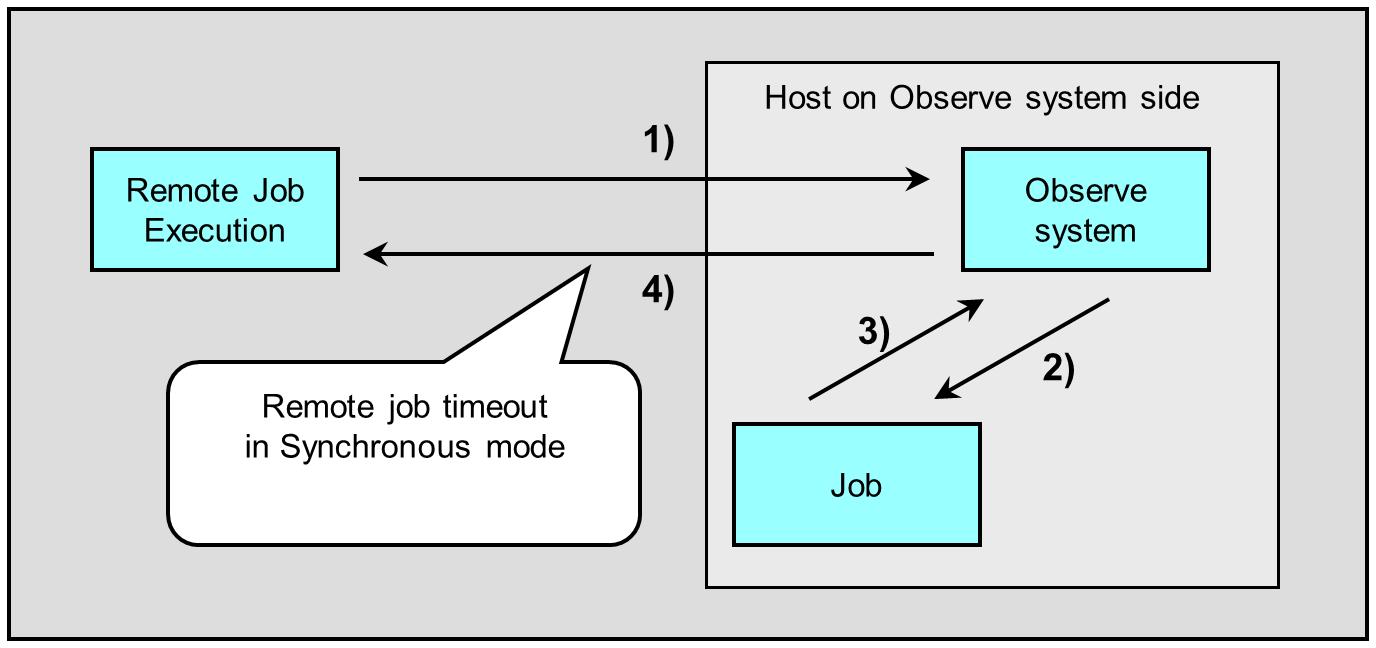Remote job timeout in Synchronous mode
For a remote job execution, the two modes are selectable: (1) HULFT waits for the job executed by the remote host to be complete (Synchronous) or (2) HULFT does not wait for the job to be complete (Asynchronous). When the remote job execution is performed in Synchronous mode, it is necessary to set the timeout for waiting for the result of the job.

Figure 4.8 Remote job timeout
1) The Remote Job Execution command sends a job execution request to the Observe system of the remote host.
This command remains in the waiting status until the job execution ends.
2) The Observe system executes the user job.
3) The Observe system waits for the job to end.
4) After the job execution is complete, the system notifies the Remote Job Execution command of the result of the job execution.
However, if the timeout value for waiting for the notification from the remote job is not long enough at 4) in the above figure, the Remote Job Execution command may be terminated when the job timeout is reached.
At that time, the behavior of the job on the Observe system side depends on the host type.
In HULFT for zOS, the job continues to run, while in HULFT for IBMi, HULFT for Linux/AIX, and HULFT for Windows, the job is forcibly terminated when the timeout is reached.
Specify the timeout value for 4) in the above figure as Job Timeout.
-
If the Observe system side is HULFT for zOS (or if the remote job of HULFT for zOS is executed), the remote job timeout you specified is rounded up to the nearest minute.
For example, if you specify 30 seconds, the remote job timeout will be rounded up to 1 minute (=60 seconds).
-
When the control is not released from the request receiving side despite the non-communication timeout is reached due to a network error or other causes, the state is handled as a communication timeout. (*1)
|
*1 |
: |
For details on non-communication timeout, refer to Non-communication timeouts. |
How to specify the timeout
In HULFT for zOS
- For the Remote Job Execution program (XRRJOBEX)
-
Specify the following in XRCARD definition card for the startup JCL:
-
TIMEOUT = wait time (seconds)
If the above parameter is not specified, 300 (seconds) is applied.
-
In HULFT for IBMi
- Remote Job Execution command (UTLRJOB)
-
Execute the command with the following parameter:
-
W= wait time (seconds)
If above parameter is not specified, Job Timeout in the System Environment Settings is used.
-
In HULFT for Linux/AIX
- Remote Job Execution command (utlrjob)
-
Execute the command with the following parameter:
-
-w wait time (seconds)
If the above parameter is not specified, Job Timeout (seconds) specified in the System Environment Settings is used.
-
In HULFT for Windows
- Remote Job Execution command (utlrjob.exe)
-
Execute the command with the following parameter:
-
-w wait time (seconds)
If the above parameter is not specified, Job Timeout specified in the System Environment Settings is used.
-